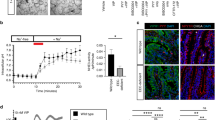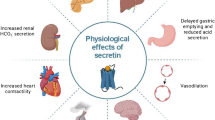Abstract
The hormone cholecystokinin is produced by the enteroendocrine I cells in the intestine, and it plays an important role in a number of physiological processes including digestion and food intake. Recent data suggest that cholecystokinin gene expression and protein secretion are regulated by macronutrients. The mechanism involves a change in intracellular levels of cAMP and Ca+2, brought about by the activity of a number of nutrient-responsive G protein-coupled receptors, nutrient transporters, ion channels and intracellular enzymes. How these intracellular responses could lead to gene expression and protein secretion are discussed along with new directions for future investigation.

Similar content being viewed by others
References
Adams JP, Roberson ED, English JD, Selcher JC, Sweatt JD (2000) MAPK regulation of gene expression in the central nervous system. Acta Neurobiol Exp (Wars) 60:377–394
Akrouh A, Halcomb SE, Nichols CG, Sala-Rabanal M (2009) Molecular biology of K(ATP) channels and implications for health and disease. IUBMB Life 61:971–978
Andrisani OM (1999) CREB-mediated transcriptional control. Crit Rev Eukaryot Gene Expr 9:19–32
Bernard C, Sutter A, Vinson C, Ratineau C, Chayvialle J, Cordier-Bussat M (2001) Peptones stimulate intestinal cholecystokinin gene transcription via cyclic adenosine monophosphate response element-binding factors. Endocrinology 142:721–729
Bhatt HS, Conner BP, Prasanna G, Yorio T, Easom RA (2000) Dependence of insulin secretion from permeabilized pancreatic beta-cells on the activation of Ca(2+)/calmodulin-dependent protein kinase II: a re-evaluation of inhibitor studies. Biochem Pharmacol 60:1655–1663
Blank PS, Cho MS, Vogel SS, Kaplan D, Kang A, Malley J, Zimmerberg J (1998) Submaximal responses in calcium-triggered exocytosis are explained by differences in the calcium sensitivity of individual secretory vesicles. J Gen Physiol 112:559–567
Brown EM (2007) The calcium-sensing receptor: physiology, pathophysiology and CaR-based therapeutics. Subcell Biochem 45:139–167
Chaikomin R, Wu KL, Doran S, Meyer JH, Jones KL, Feinle-Bisset C, Horowitz M, Rayner CK (2008) Effects of mid-jejunal compared to duodenal glucose infusion on peptide hormone release and appetite in healthy men. Regul Pept 150:38–42
Chang CH, Chey WY, Chang TM (2000) Cellular mechanism of sodium oleate-stimulated secretion of cholecystokinin and secretin. Am J Physiol Gastrointest Liver Physiol 279:G295–G303
Chang CH, Chey WY, Sun Q, Leiter A, Chang TM (1994) Characterization of the release of cholecystokinin from a murine neuroendocrine tumor cell line, STC-1. Biochim Biophys Acta 1221:339–347
Cheng X, Ji Z, Tsalkova T, Mei F (2008) Epac and PKA: a tale of two intracellular cAMP receptors. Acta Biochim Biophys Sin (Shanghai) 40:651–662
Choi S, Lee M, Shiu AL, Yo SJ, Halldén G, Aponte GW (2007) GPR93 activation by protein hydrolysate induces CCK transcription and secretion in STC-1 cells. Am J Physiol Gastrointest Liver Physiol 292:G1366–G1375
Conigrave A, Brown E (2006) Taste receptors in the gastrointestinal tract II. L-amino acid sensing by calcium-sensing receptors: implications for GI physiology. Am J Physiol Gastrointest Liver Physiol 291:G753–G761
Covington DK, Briscoe CA, Brown AJ, Jayawickreme CK (2006) The G-protein-coupled receptor 40 family (GPR40-GPR43) and its role in nutrient sensing. Biochem Soc Trans 34:770–773
Cummings DE, Overduin J (2007) Gastrointestinal regulation of food intake. J Clin Invest 117:13–23
Darcel NP, Liou AP, Tomé D, Raybould HE (2005) Activation of vagal afferents in the rat duodenum by protein digests requires PepT1. J Nutr 135:1491–1495
Deschenes RJ, Lorenz LJ, Haun RS, Roos BA, Collier KJ, Dixon JE (1984) Cloning and sequence analysis of a cDNA encoding rat preprocholecystokinin. Proc Natl Acad Sci USA 81:726–730
Dyer J, Salmon KS, Zibrik L, Shirazi-Beechey SP (2005) Expression of sweet taste receptors of the T1R family in the intestinal tract and enteroendocrine cells. Biochem Soc Trans 33:302–305
Dyer J, Vayro S, King TP, Shirazi-Beechey SP (2003) Glucose sensing in the intestinal epithelium. Eur J Biochem 270:3377–3388
Friedman J, Schneider BS, Powell D (1985) Differential expression of the mouse cholecystokinin gene during brain and gut development. Proc Natl Acad Sci USA 82:5593–5597
Gevrey JC, Cordier-Bussat M, Némoz-Gaillard E, Chayvialle JA, Abello J (2002) Co-requirement of cyclic AMP- and calcium-dependent protein kinases for transcriptional activation of cholecystokinin gene by protein hydrolysates. J Biol Chem 277:22407–22413
Hand KV, Bruen CM, Halloran FO, Giblin L, Green BD (2010) Acute and chronic effects of dietary fatty acids (FAs) on cholecystokinin (CCK) expression, storage and secretion in enteroendocrine STC-1 cells. Mol Nutr Food Res. doi:10.1002/mnfr.200900343
Hansen TV (2001) Cholecystokinin gene transcription: promoter elements, transcription factors and signaling pathways. Peptides 22:1201–1211
Hira T, Nakajima S, Eto Y, Hara H (2008) Calcium-sensing receptor mediates phenylalanine-induced cholecystokinin secretion in enteroendocrine STC-1 cells. FEBS J 275:4620–4626
Hirasawa A, Tsumaya K, Awaji T, Katsuma S, Adachi T, Yamada M, Sugimoto Y, Miyazaki S, Tsujimoto G (2005) Free fatty acids regulate gut incretin glucagon-like peptide-1 secretion through GPR120. Nat Med 11:90–94
Hirsh AJ, Cheeseman CI (1998) Cholecystokinin decreases intestinal hexose absorption by a parallel reduction in SGLT1 abundance in the brush-border membrane. J Biol Chem 273:14545–14549
Ichimura A, Hirasawa A, Hara T, Tsujimoto G (2009) Free fatty acid receptors act as nutrient sensors to regulate energy homeostasis. Prostaglandins Other Lipid Mediat 89:82–88
Illario M, Cavallo AL, Bayer KU, Di Matola T, Fenzi G, Rossi G, Vitale M (2003) Calcium/calmodulin-dependent protein kinase II binds to Raf-1 and modulates integrin-stimulated ERK activation. J Biol Chem 278:45101–45108
Ivy AC, Oldberg E (1928) A hormone mechanism for gallbladder contraction and evaluation. Am J Physiol 65:599–613
Konturek SJ, Radecki T, Thor P, Dembinski A (1973) Release of cholecystokinin by amino acids. Proc Soc Exp Biol Med 143:305–309
Lee CW, Rivera R, Gardell S, Dubin AE, Chun J (2006) GPR92 as a new G12/13- and Gq-coupled lysophosphatidic acid receptor that increases cAMP, LPA5. J Biol Chem 281:23589–23597
Liddle RA (1994) Regulation of cholecystokinin synthesis and secretion in rat intestine. J Nutr 124:1308S–1314S
Liddle RA, Goldfine ID, Rosen MS, Taplitz RA, Williams JA (1985) Cholecystokinin bioactivity in human plasma: molecular forms, responses to feeding, and relationship to gallbladder contraction. J Clin Invest 75:1144–1152
Liddle RA, Misukonis MA, Pacy L, Balber AE (1992) Cholecystokinin cells purified by fluorescence-activated cell sorting respond to monitor peptide with an increase in intracellular calcium. Proc Natl Acad Sci USA 89:5147–5151
Maljaars J, Romeyn EA, Haddeman E, Peters HP, Masclee AA (2009) Effect of fat saturation on satiety, hormone release, and food intake. Am J Clin Nutr 89:1019–1024
Mangel AW, Prpic V, Scott L, Liddle RA (1994) Inhibitors of ATP-sensitive potassium channels stimulate intestinal cholecystokinin secretion. Peptides 15:1565–1566
Mangel AW, Snow ND, Misukonis MA, Basavappa S, Middleton JP, Fitz JG, Liddle RA (1993) Calcium-dependent regulation of cholecystokinin secretion and potassium currents in STC-1 cells. Am J Physiol 264:G1031–G1036
Matsumura K, Miki T, Jhomori T, Gonoi T, Seino S (2005) Possible role of PEPT1 in gastrointestinal hormone secretion. Biochem Biophys Res Commun 336:1028–1032
McCaughey SA (2008) The taste of sugars. Neurosci Biobehav Rev 32:1024–1043
Moran TH, Kinzig KP (2004) Gastrointestinal satiety signals II. Cholecystokinin. Am J Physiol Gastrointest Liver Physiol 286:G183–G188
Némoz-Gaillard E, Bernard C, Abello J, Cordier-Bussat M, Chayvialle JA, Cuber JC (1998) Regulation of cholecystokinin secretion by peptones and peptidomimetic antibiotics in STC-1 cells. Endocrinology 139:932–938
Neri LM, Borgatti P, Capitani S, Martelli AM (2002) Protein kinase C isoforms and lipid second messengers: a critical nuclear partnership? Histol Histopathol 17:1311–1316
Nishi T, Hara H, Tomita F (2003) The soybean beta-conglycinin beta 51-63 fragment suppresses appetite by stimulating cholecystokinin release in rats. J Nutr 133:2537–2542
Pilichiewicz AN, Chaikomin R, Brennan IM, Wishart JM, Rayner CK, Jones KL, Smout AJ, Horowitz M, Feinle-Bisset C (2007) Load-dependent effects of duodenal glucose on glycemia, gastrointestinal hormones, antropyloroduodenal motility, and energy intake in healthy men. Am J Physiol Endocrinol Metab 293:E743–E753
Raybould HE (1999) Nutrient tasting and signaling mechanisms in the gut I. Sensing of lipid by the intestinal mucosa. Am J Physiol 277:G751–G755
Raybould HE (2008) Nutrient sensing in the gastrointestinal tract: possible role for nutrient transporters. J Physiol Biochem 64:349–356
Rey O, Young SH, Papazyan R, Shapiro MS, Rozengurt E (2006) Requirement of the TRPC1 cation channel in the generation of transient Ca 2+ oscillations by the calcium-sensing receptor. J Biol Chem 281:38730–38737
Rey O, Young SH, Yuan J, Slice L, Rozengurt E (2005) Amino acid-stimulated Ca2+ oscillations produced by the Ca2 + -sensing receptor are mediated by a phospholipase C/inositol 1, 4, 5-trisphosphate-independent pathway that requires G12, Rho, filamin-A, and the actin cytoskeleton. J Biol Chem 280:22875–22882
Riccio A, Medhurst AD, Mattei C, Kelsell RE, Calver AR, Randall AD, Benham CD, Pangalosa MN (2002) mRNA distribution analysis of human TRPC family in CNS and peripheral tissues. Brain Res Mol Brain Res 109:95–104
Rozengurt E, Sternini C (2007) Taste receptor signaling in the mammalian gut. Curr Opin Pharmacol 7:557–562
Schneeman BO (2002) Gastrointestinal physiology and functions. Br J Nutr 88:S159–S163
Stojilkovic SS (2005) Ca2+-regulated exocytosis and SNARE function. Trends Endocrinol Metab 16:81–83
Swulius MT, Waxham MN (2008) Ca (2+)/calmodulin-dependent protein kinases. Cell Mol Life Sci 65:2637–2657
Szaszák M, Christian F, Rosenthal W, Klussmann E (2008) Compartmentalized cAMP signalling in regulated exocytic processes in non-neuronal cells. Cell Signal 20:590–601
Takahashi Y, Kato K, Hayashizaki Y, Wakabayashi T, Ohtsuka E, Matsuki S, Ikehara M, Matsubara K (1985) Molecular cloning of the human cholecystokinin gene by use of a synthetic probe containing deoxyinosine. Proc Natl Acad Sci USA 82:1931–1935
Tanaka T, Katsuma S, Adachi T, Koshimizu TA, Hirasawa A, Tsujimoto G (2008) Free fatty acids induce cholecystokinin secretion through GPR120. Naunyn Schmiedebergs Arch Pharmacol 377:523–527
Thwaites DT, Anderson CM (2007) H+-coupled nutrient, micronutrient and drug transporters in the mammalian small intestine. Exp Physiol 92:603–619
Veldhorst M, Smeets A, Soenen S, Hochstenbach-Waelen A, Hursel R, Diepvens K, Lejeune M, Luscombe-Marsh N, Westerterp-Plantenga M (2008) Protein-induced satiety: effects and mechanisms of different proteins. Physiol Behav 94:300–307
West SD, Mercer DW (2004) Cholecystokinin-induced gastroprotection: a review of current protective mechanisms. Dig Dis Sci 49:361–369
Author information
Authors and Affiliations
Corresponding author
Rights and permissions
About this article
Cite this article
Nilaweera, K.N., Giblin, L. & Ross, R.P. Nutrient regulation of enteroendocrine cellular activity linked to cholecystokinin gene expression and secretion. J Physiol Biochem 66, 85–92 (2010). https://doi.org/10.1007/s13105-010-0012-z
Received:
Accepted:
Published:
Issue Date:
DOI: https://doi.org/10.1007/s13105-010-0012-z




